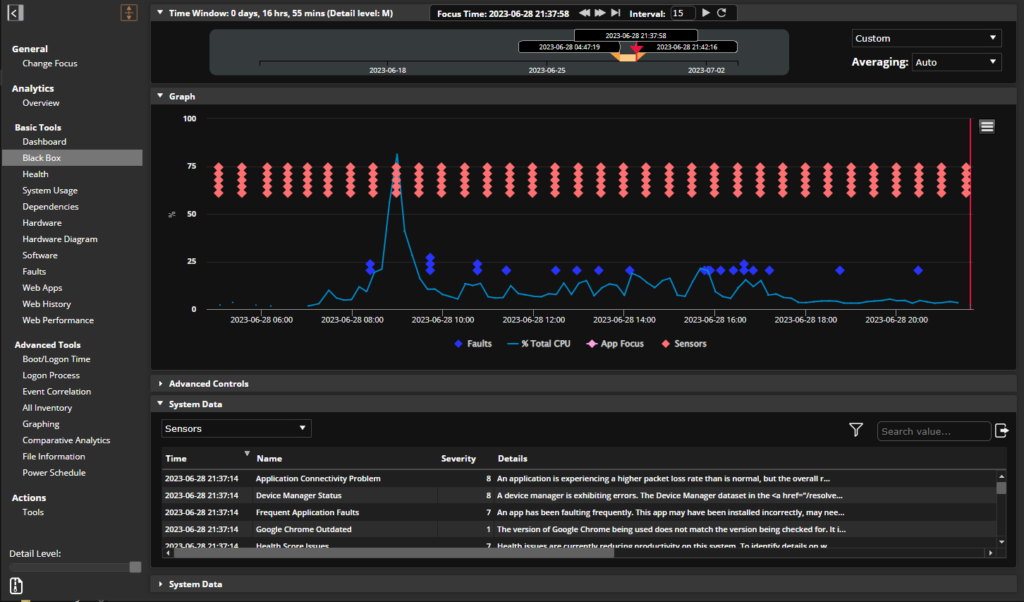
Discover the reasons for and benefits of shifting service desk operations further to the left, and how Lakeside can help
Recent trends in IT service management (ITSM) accentuate the importance of proactive IT. The goal is to prevent problems before they occur — a strategy that helps to reduce support desk costs and improve end-user experience. With more efficient IT operations and increased employee productivity, corporations are better positioned to meet business goals.
Although IT teams are encouraged to shift to proactive support models, they should not neglect the value of having effective reactive processes in place, too. Reducing the time to resolve tech issues is a key priority for 58% of the IT staff surveyed in Lakeside Software’s study on digital employee experience.
Reactive vs. Proactive IT Operations
Support desks use two main approaches when dealing with service delivery:
- With reactive IT, the focus is on repair. A user reports a problem first, then an IT technician troubleshoots to fix the issue.
- With proactive IT, the focus is on prevention. The support team remediates incidents before they spread and impact productivity.
Benefits of Proactive Support Desk
Endpoint monitoring, automation, and artificial intelligence (AI) are all crucial to building effective help desk operations. According to Lakeside’s research, 72% of surveyed IT staff indicated that proactive resolution of incidents before they begin is one of the most valuable capabilities to automate IT operations.
Common IT issues that could be predicted and remediated proactively include high CPU and memory usage, low disk space, and repeated blue screens of death. Proactive service is still in the early stages, though. Gartner predicts that only 30% of customer service and support organizations will have a proactive approach by 2023.
Proactive monitoring benefits include:
- Lower help desk ticket volumes
- Reduced downtime
- Higher user productivity
- Increased employee satisfaction
Proactive IT enables not only efficient incident resolution but also enhanced resource optimization. Organizations can proactively monitor their environment to assess the software and devices employees use to make data-informed procurement decisions based on their needs.
The process of right-sizing resources drives significant savings for organizations as well. For example, insurance group PPS saved over $400,000 in overprovisioned licensing by deploying Lakeside’s Digital Experience Cloud, powered by SysTrack.
Lakeside’s platform also helped PPS to improve the digital experience thanks to efficient root cause analysis.
“We used SysTrack to identify a clear trend on which times of the day users appeared to be having issues and how many blue screens users were actually being experienced. We found that complaints were actually well-founded, and we were able to find the root cause of them.”
Senior Manager, PPS
How to Implement Proactive Monitoring
More proactive IT operations are able to shift left. That means they handle incidents on a lower support level, freeing more skilled specialists to focus on higher-value tasks. This approach brings cost savings to organizations — in fact, escalating tickets from support Level 1-3 costs twice more.
Proactive monitoring enables organizations to create Level 0 support, in which users can solve problems without IT assistance. Self-healing IT automation also makes it possible to automatically deploy patches, updates, or other fixes in the background. These strategies resolve incidents before they require the attention of L1 technicians.
Here are some features that make Lakeside Prevent — part of Lakeside’s Digital Experience Cloud — a powerful tool to enable a proactive support desk:
Automated incident detection and resolution
Through the use of intelligent sensors, IT can monitor the environment in real-time to identify developing issues and trigger alerts or responses when certain thresholds are reached. It’s possible to execute scripts automatically to solve incidents before users are impacted.
Prioritization of top issues
Lakeside’s proactive IT tool organizes issues based on severity and number of systems impacted, allowing technicians to quickly identify which incidents to address first to minimize the impact on the digital experience.
Discovery of predictive patterns
By leveraging endpoint data and artificial intelligence, it’s possible to make predictions about future issues and prevent them from happening.
Why You Still Need Reactive Support
Efficient root cause analysis (RCA) is vital for any kind of IT support model. And by applying artificial intelligence and machine learning, automated RCA enables organizations to solve issues rapidly because it investigates the source of problems, not just symptoms.
That makes automated root cause analysis a foundational part of proactive support. By understanding context and making correlations between events, automated RCA draws actionable insights and helps prevent repeat issues from happening.
The Importance of User Experience Data and AI-Driven Insights
This shift from reactive to proactive operations requires comprehensive visibility into the digital environment. That has been a key driver for the adoption of digital experience management (DEM) platforms such as Lakeside’s Digital Experience Cloud. As per IT staff surveyed in Lakeside’s study, these are the most valuable use cases for experience management:
- Root cause analysis and prevention
- End-user productivity
- Reduction in volume of IT tickets
IT teams can measure the success of their initiatives by looking at the impact on employee productivity. That’s why it’s critical to monitor the end-user experience and obtain holistic visibility across the digital environment. With Lakeside’s platform, organizations can calculate an end-user experience score that quantifies the amount of time an employee cannot work due to tech issues and poor digital experience.
Subscribe to the Lakeside Newsletter
Receive platform tips, release updates, news and more



